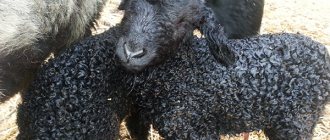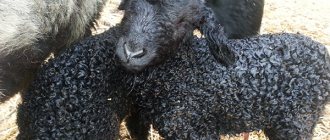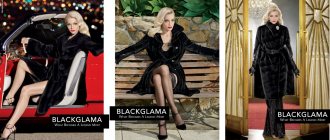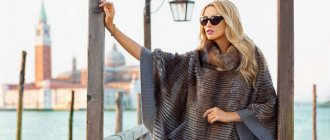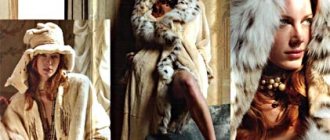In winter, you especially want to feel warm and comfortable, so choose your winter shoes carefully. Pay attention to the materials of the upper and lining. In one of the articles we discussed genuine leather and nubuck. Now let's look at internal insulation. So, what is warmer: fur or wool? What material is preferable for the winter season? Manufacturers use felt, natural and artificial fur, fleece, and sheepskin as lining. They warm your feet, are pleasant to the touch, and provide air exchange inside the shoes. Boots and shoes use fur and wool as lining. We chose these materials because of their good performance.
Sheepskin in modern fashion
The well-known phrase “Sheepskin is not worth the candle” is not about sheepskin fur, which is extremely popular, despite its centuries-old age and competition among its more fluffy relatives. Sheepskin coats or “Siberian sheepskin coats,” as they are called in the West, are fashionable, comfortable and practical everyday clothing.
Fashionable sheepskin coats and sheepskin coats are also relevant, only the style has changed a little. They are beautiful, warm and comfortable, with a high, voluminous collar or a fold-over double collar. The length can be either short or extended to the knees.
It is preferable to choose sheepskin products in brown colors - chocolate, cream, sand. But the color scheme may not be limited to one shade and amaze the imagination with the play of a wide variety of tones, from snow-white to blue.
Short sheepskin jackets with a large fox or arctic fox collar look very stylish. Also distinctive are short military-style aviator jackets, decorated with leather straps and metal details.
Sheepskin coats look great in an ensemble with mini shorts, a pencil skirt, leather trousers and a knitted dress. However, stylists warn: do not overdo it with volume. If the upper part of your silhouette is voluminous, then it is advisable to visually narrow the lower part.
Sheepskin production
Sheepskin is a skin taken from an adult sheep and young animals over 6 months old. The structure of sheepskin wool is characterized by a thin epidermis. The dermis consists of thin fibers intertwined in a horizontal direction. The boundary between the papillary and reticular layers of the dermis is quite clear. The thickness of the papillary layer is usually greater than the thickness of the reticular layer. Sheepskin leather and fur have low strength, especially the outer layer of the skin, strong ductility, high looseness and water permeability. Mereya leather made from sheepskin has evenly distributed small pores and a fairly smooth surface.
Based on the hair structure, sheep are classified into: fine-fleece, semi-fine-fleece, semi-coarse-wool and coarse-wool.
Sheepskin is a popular type of fur raw material. There are three groups of sheepskin: fur, fur and leather.
In fur production, fine-fleece, semi-fine-fleece, fine-fleece and coarse-wool sheep are used, with uniform or heterogeneous semi-coarse wool with a significant fluff content. Which have secondary hair, which consists of thin, thick hair (staple fleece). It contains up to 35% fat from the weight of the fleece, which gives the hair a yellowish tint. The hair coat of fine-fleece and semi-fine-fleece sheep consists mainly of downy hair. The fleece of semi-coarse-wool sheep contains transitional and guard hairs. According to the height of the hair, sheepskin is divided into wool (over 5 cm), half-wool (from 2 to 5 cm) and bare (up to 2 cm).
Depending on the breed and quality of hair, sheep are divided into types - Russian, steppe, Mongolian, Romanov. Sheepskin fur is used to make women's and children's coats, men's and women's collars, and hats, with the hair facing outward. Fur sheepskin is used for sheepskin coats. Sometimes covered with a film for a waterproof effect.
In the sheepskin and fur production, coarse-wooled sheep are used, with heterogeneous, mixed wool of at least 1.5 cm in length. From the fur sheepskin, after dressing and dyeing, headwear is made - short fur coats, sheepskin coats, jackets. In this case, the skin part of the sheepskin (mesh) faces outward, and the wool faces inward. The most suitable for sheepskin and fur production are the skins of sheep of the Romanov breed, especially at the age of 5-8 months. The ratio of the number of downy and guard hairs in the wool of the Romanov sheep prevents felting and ensures the preservation of the curl during wear, which gives it good heat-protective properties.
In leather production, sheep skins are used, the quality of the hair does not meet the requirements of fur and sheepskin production. Sheep skins used for leather production are divided into 4 groups:
— Russian, includes the skins of all coarse-wool sheep breeds, with the exception of fat-tailed ones. Suitable for the production of chrome-tanned leather for shoe uppers - chevrette.
— Steppe, includes the skins of fat-tailed and adult Karakul sheep. The skins are very oily, so the skins are loose, viscous and have a weak, fragrant (easily crushed, separated) outer layer. They are used to produce haberdashery, lining and mitten leather.
- Crossbred.
— Fine-wool sheepskin.
Depending on the origin of the sheep and the method of dressing, there are many names for sheepskin: smushka, merlushka, golyak, moire, klyam, strap and others.
Golyak, moire, klyam - the skins of unborn lambs of coarse-wool sheep. The hairline has just begun to develop, with a smooth moiré pattern. Klyam with longer hair (maybe from a 1-2 day old lamb). Used for making women's coats, jackets, and finishing clothes.
Smushka is the skin of lamb from the Smushkov breeds, aged 2-4 days. The hair is soft and slightly shiny with loose curls. Used for various fur products.
Merlushka is the skin of lamb up to 1 month old. Hair in the form of curls. Used for making coats, jackets, hats, collars, muffs.
Strap or slink are the skins of newborn lambs of semi-coarse-wool and fine-wool sheep breeds. White thick hair. There are skins in which the ends of the hair are curled in the form of a ring or polka dots. They are made shorn with a hair height of 0.6-1.6 cm. The skins are similar to broadtail, but have a smaller curl and can be used on both sides. The size of slink skins does not exceed 25 sq.dm. Used for sewing demi-season children's coats, hats, and collars.
Merino is a breed of fine-wool sheep whose fur is more valuable than others. For the production of sheepskin material, Spanish merino is mainly used, since it has the thinnest and most elastic leather. Spanish merino skins are not large, the average size is 55-65 sq.dm. The fur of merino skins is soft and silky. Sheepskin coats made from merino sheepskin material are light, comfortable and very warm at the same time. Since the color of this breed of sheep is white, Merino sheepskin material can be of any colors and with various treatments and coatings of the leather fabric.
Merinillo is the skins of Merino lambs aged 4-5 months. Compared to merino, these skins are lighter and more delicate, but have one drawback - their size is no more than 35 sq.dm.
Tuscany is a sheepskin material made from Tuscan lamb, which gets its name from the name of the region in Italy. This breed is also raised in Spain. Tuscan skins are small, on average 35-40 sq.dm. This is the warmest type of sheepskin material, since the hair of this lamb is not cut, its length varies within 4-5 cm. Sheepskin coats made from Tuscan skins do not require additional decoration with valuable furs, since the fur of this lamb itself looks luxurious.
Tigrado is a sheepskin material for lambs with pronounced curly fur. The length of the pile of Tigrado skins is 4-5 cm, the size of the skins is 35-40 sq.dm. Sheepskin coats have good elasticity, lightness and high warming characteristics. Tigrado has increased in fashion in recent times due to its ethnic character.
Rozado - Skins of Tuscan lambs with a fur cutting height of 5 - 6 mm. This is a thin, delicate, flexible and warm sheepskin that allows a clothing designer to realize the most daring ideas.
Intrefino. This sheepskin material is characterized by subtlety and grace. Sheepskin coats sewn from it always look very elegant, neat and beautiful. For its production, sheep skin is used, due to which a recognizable texture is formed and a “warm atmosphere” is created. No matter how bad the weather is outside, you will always look very stylish in a sheepskin coat made of this material.
Mouton (fr. mouton ram, valukh, sheepskin) is a sheepskin dressed in a special way. Mouton is a very unpretentious fur, resistant to wet snow and wind. To produce it, the skins are treated with formaldehyde, due to which each hair is “preserved” and becomes resistant to influence. The skins from which the mouton is made are of Australian origin.
Astragan (a type of mouton). This type of fur is a special grade (highest quality) sheepskin that has been specially processed. To obtain astragan, modern methods of processing semi-finished fur products (sheepskin) are used. For the visual effect of "astragan" you need a sheepskin with a strong curl of hair and a densely stuffed down. The fur hairline is cut much shorter than that of a regular mouton. Due to the curl of the hair, when the fur is cut short (0.5 -0.7 cm), an effect visually similar to broadtail is obtained. Astragan is much lighter than a regular mouton. The heat-saving properties are not inferior to ordinary mouton. In terms of wearability, this material is much superior to a regular mouton, since thanks to the short haircut, the hair does not roll off and a fur coat made from this type of fur does not lose its excellent appearance for at least 3 years of its active use. Products made from astragan are on average 30% more expensive than similar fur coats and products made from mouton.
When processing sheep skins, the most modern technical means and technologies are used, so all the positive properties of sheepskin are doubled and tripled. Sheep skins go through several stages of processing: drying, degreasing the flesh, defatting, first warm-up, drying, second warm-up, second drying, scratching, polishing, beating. The sheepskin becomes soft, flexible, light, and a little rough to the touch.
Wool insulation
also produces wool-lined shoes. Lightweight winter models will provide comfort and warmth in severe frost. They cost less and look great! Wool and felt have a dense structure. Many weaves keep warm air inside well. The higher the density of the pile, the better the thermal insulation, the warmer the shoes or boots. It is typical that during wear the fibers become even more compressed and compacted. The shoes become warmer.
Benefits of wool:
- Contains natural fibers,
- Has an optimal density of pile filling,
- Shoes can be worn at temperatures from zero to very low,
- Durable, practical, not subject to abrasion,
- Boots or boots with wool insulation are lighter, more elegant,
- Shoes made with natural wool are affordable.
Choose insulation and shoes based on weather conditions, your own feelings, and financial capabilities. We’ll tell you in what cases the first or second material is suitable.

